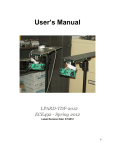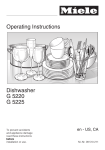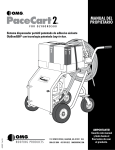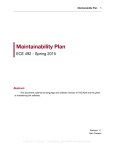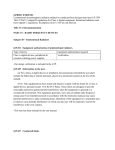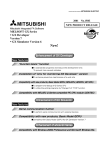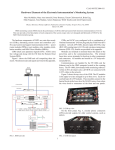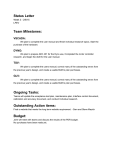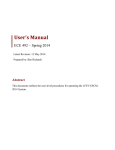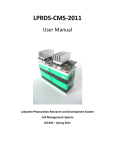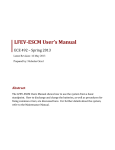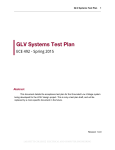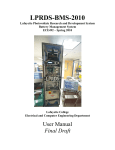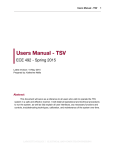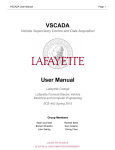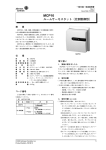Download LFEV-Y3-2015-01-20 - Sites at Lafayette
Transcript
1 LFEV-Y3-2015 Lafayette Formula Electric Vehicle Year 3 ECE492 – Spring 2015 Statement of Work PRELIMINARY DRAFT Lafayette College Electrical and Computer Engineering Department 20 January 2015 2 Table of Contents Scope................................................................................................................................... 4 Management Requirements ................................................................................................ 5 Labor Resources, Management, and Organization ......................................................... 5 Teamwork ................................................................................................................... 6 Overhead Resources........................................................................................................ 6 Budget for Direct Costs .............................................................................................. 7 Non Budget Items ....................................................................................................... 7 Acceptance Testing..................................................................................................... 7 System Integration ...................................................................................................... 8 Preliminary Design ......................................................................................................... 8 Preliminary Design Review (PDR)............................................................................. 9 Critical Design Review (CDR) ................................................................................. 10 Hardware Purchasing Deadline (HPD)..................................................................... 10 Final Delivery Date (FDD) ....................................................................................... 11 Deliverables and Data Items ............................................................................................. 12 D000: PDR Materials.................................................................................................... 13 D001: CDR Materials ................................................................................................... 14 D002: Users Manual ..................................................................................................... 15 D003: Final Report and Maintenance Manual.............................................................. 16 D004: Acceptance Test Plan......................................................................................... 16 D005: Acceptance Test Report ..................................................................................... 17 D006: QA Audit Report................................................................................................ 18 D007: Project Web Site ................................................................................................ 18 D008: LFEV-Y3-2015 Integrated System and Presentation ........................................ 18 D009: Conference Paper, Presentation, and Video....................................................... 19 D010: Project Poster ..................................................................................................... 19 D011: Calibration and Accuracy Analysis ................................................................... 19 D012: Maintainability Plan........................................................................................... 19 D013: Individual Research Report................................................................................ 20 D014: Project Management and Status Letters............................................................. 20 3 D015: Project Interface Control Document .................................................................. 21 Technical Requirements.................................................................................................... 22 Detailed Requirements.................................................................................................. 22 R000: Formula Hybrid Competition Rules............................................................... 22 R001: Use of the Previous Year’s Design ................................................................ 23 R002: VSCADA ....................................................................................................... 23 R003: VSCADA API, SDK, and Applications......................................................... 27 R004: TSV Battery Pack Accumulator Requirements.............................................. 27 R005: Motor, Controller, and Dynamometer Test Stand.......................................... 30 R006: GLV Power .................................................................................................... 31 R007: Safety Loop .................................................................................................... 31 R008: TSV Load Controller...................................................................................... 32 General Project Requirements ...................................................................................... 32 Special Waivers and Restrictions.............................................................................. 32 GPR001: Documentation .......................................................................................... 33 GPR003: EMI/EMC ................................................................................................. 34 GPR004: Hazmats..................................................................................................... 34 GPR005: Safety and Good Practice.......................................................................... 34 GPR006: Reliability.................................................................................................. 37 GPR007: Maintainability .......................................................................................... 37 GPR008: Manufacturability...................................................................................... 38 GPR011: Project Video and Final Demonstration.................................................... 39 GPR012: Final Disposal of Projects ......................................................................... 39 Acronym Glossary ............................................................................................................ 41 4 Scope Lafayette College ECE Department is pleased to propose the design, fabrication, and testing of a Motor Controller System (MCS), Dynamometer System (Dyno), an improved Vehicle System Control And Data Acquisition (VSCADA) system, an improved accumulator for Tractive System Voltage (TSV), and a Grounded Low Voltage (GLV) electrical system along with mechanical design for the packaging, integration, and operation of these systems into a Lafayette Formula Electric Vehicle (LFEV). The LFEV is intended to be a future entry in the IEEE Formula Hybrid competition beginning in the spring of 2016. LFEV-Y3-2015 is the third year in the multi-year project. The first year (LFEV-ESCM2013) delivered several basic prototype components for LFEV use, including a prototype 3-cell battery. The Phase 2 effort of LFEV-Y3-2015 improved and extended this work, completing a full-spec 7-cell battery prototype as well as specifying, justifying, and procuring a motor, controller, and dynamometer. LFEV-Y3-2013 shall take the final steps toward a competition ready LFEV and will deliver: • • • • • A competition ready, 96 Volt LiFePO4 accumulator for TSV consisting of four, 7-cell packs, built and tested, with updated hardware, updated pack firmware, and fully interfaced to vehicle systems Vehicle SCADA software, built and tested, and fully interfaced to vehicle systems, remote computers, and Dyno DAQ. GLV electrical, including SCADA hardware, Dashboard, Safety Loop, Load Control, GLV Power, built and tested, interfaced to Dyno system. Dynamometer system with DAQ sensors, motor, and controller, built and tested, interfaced with all support systems: TSV, GLV, and SCADA. Preliminary vehicle mechanical design for the packaging of TSV, GLV, and motor/controller on a Formula car chassis. This system shall be developed in Acopian Engineering Center and shall reliably, safely, and maintainably operate over a 5-year service life. This document describes the detailed requirements for the project. 5 Management Requirements The LFEV-Y3-2015 shall be designed, developed, fabricated, tested, demonstrated, and documented by coordinated student teams during a challenging one-term (14 week) schedule. Each student team first conducts a Preliminary Design Review where that team presents a comprehensive system design and test plan to faculty reviewers and their peer teems. Based on feedback from the review and additional effort teams then refine this plan and conduct a Critical Design Review, followed by fabrication, development, and testing. Overall project management and inter-team coordination is also required. Labor Resources, Management, and Organization Teams of Lafayette College students shall comprise the main engineering labor pool. Teams shall have 4-6 members. The students involved in this project must establish processes for organizing, planning, and allocating work to individuals and teams. A reliable process for closed loop intra-team communication and management must be developed. Design project teams are student led. The full responsibility for project management and production of deliverables lies with the individual student team. Nevertheless, engineering division professors are specifically allocated to support this effort as consultants throughout the term. On a time-available basis, additional Lafayette professors may consult with the team as required. Testing of deliverables is defined by students and executed by students. Engineering faculty has the right to review, participate in, and direct testing activities, but these professors have no obligation to do so. Professors do not explicitly correct and grade your work as they do in other courses. When the team creates a text document, computer program, physical part, assembly, or other deliverable, the team itself is responsible for inspecting and documenting that the deliverable meets requirements. How well students work together as a team correlates strongly with project success. Team members must communicate with each other, and ensure that all members contribute meaningfully to each meeting and to the project as a whole. Face-to-face meetings of the whole team are essential. Past experience has shown that excessive reliance on open-loop electronic communication (e.g. email, texting, google apps, etc… ) can be counterproductive. The team must communicate closed-loop, physically meet, and actively inspect first-hand the work of all team members. You get what you inspect, not what you expect. Inexperienced teams tend to divide up complex projects so that individuals or small groups can work on separate parts independently. This is often a big problem. Although division of labor can be valuable, communication and mutual performance monitoring is far more important. To make matters worse, dividing the system naively into convenient chunks can result in a bunch of “parts” that don’t integrate into a working “whole”. In complex engineering tasks, a divide-and-conquer strategy does not lead to success unless the independent work is carefully planned, 6 coordinated, and mutually inspected by a strong team oriented effort. Teamwork Successful teams embrace these important aspects of teamwork: Team Orientation: reflects acceptance of team norms, level of group cohesiveness and importance of team membership. It is a propensity to take other’s behavior into account during group interaction and the belief in the importance of team goals over individual member goals. Shared mental models, mutual trust, and closed loop communication enhance team orientation. Team Leadership: Involves providing direction, structure and support for other team members. It does not necessarily refer to a single individual with formal authority over others. Several team members can show team leadership. Leaders direct and coordinate the activities of other team members, assess team performance, assign tasks, develop team knowledge, skills, and abilities, motivate team members, plan and organize, and establish a positive atmosphere. Mutual Performance Monitoring: Refers to observing the activities and performance of other team members and recognizing when a team member performs correctly. Team members both seek and give feedback. Giving feedback refers to providing information regarding other members’ performance. Seeking feedback refers to requesting input or guidance regarding performance and to accepting positive and negative information regarding performance. This all implies that team members are individually competent, engage in closed loop communication, trust each other, and have a shared mental model. Back-up Behavior: Involves assisting the performance of other team members. This implies that members have an understanding of other members’ tasks. It also implies that team members are willing and able to provide and seek assistance when needed. This includes the ability to shift workload among members to achieve balance during high periods of workload or pressure. Adaptability: Ability to adjust strategies based on information gathered from the environment through the use of backup behavior and reallocation of intra-team resources. Altering a course of action or team repertoire in response to changing conditions (internal or external). Implies the ability to recognize and communicate that a change has occurred. Overhead Resources The student teams should not attempt to build everything from scratch. Some items should be purchased outright. Experienced technicians should fabricate other items. The Lafayette College Engineering Division shops and labs shall be the primary technical resource for professional fabrication. External contract fabrication facilities may be utilized when necessary, subject to the budget for direct costs. All fabricators must be located in the USA. 7 The team should be aware of the lead-time required by the machine shop and other resources, factoring this time into the project schedule. Students may not submit un-reviewed “sketches” to the machine shop for fabrication. All drawings must be prepared according to GPR001 standards and bear review signatures BEFORE being submitted to the machine shop. Budget for Direct Costs Direct costs, including shipping costs for the entire LFEV-Y3-2015 shall be limited to a total of $5,000 US, initially allocated equally per team. Teams can negotiate reallocation of these funds, revising their individual budgets. No expenditures will be approved till the project has developed a detailed budget. All purchases must fit within pre-established budget constraints. Any direct item to be purchased must be requested on a Lafayette ECE Department Purchase Request form. An ECE professor must approve all requests. The team shall keep a binder or spreadsheet with all approved purchase request forms. These should be tracked by the team against orders and received material. It is recommended that a single individual be assigned for managing material procurement. The ECE Department Secretary will not accept unapproved requests nor will the Secretary accept requests that are not on the standard form. Basis for approval will be the degree to which the expense fits with the project plan of record. Overnight shipping will not be approved. Running totals of costs incurred should be updated daily or even in real time if necessary, especially near the purchasing deadline. Updated cost reports and budgets shall accompany requests for major purchases. Received material without special safety considerations may be stored in the empty cabinets and shelves in room 412 and/or 400. It is the responsibility of the team to receive, inventory, and preserve the stock of received material. Non Budget Items In exceptional situations certain “big ticket” items must be purchased for the project with funds that are outside the general project budget. Non-budget funding for such items may be sought from the Engineering Division subject to the approval of Engineering faculty. All such requests much be accompanied by written justification and must be submitted to faculty no later than CDR. Acceptance Testing The ultimate goal of the project is on-time acceptance of all deliverables. To this end, deliverable acceptance comprises the Acceptance Test Plan (ATP) and the Acceptance Test Report (ATR). All specified requirements must either be waived by written agreement prior to CDR, or demonstrated in the ATP/ATR by analysis, test, or inspection. On Time Deliverables and Acceptance Testing 8 comprise the largest fraction of your grade. Each of the teams must produce a separate ATP/ATR and other required deliverables. Everyone in the team gets the same project success portion in his or her grade as measured by the quality and timeliness of the ATP/ATR and its supporting deliverables (primarily the design review material, subsystem QA report and analysis memos). Thus, the importance of documenting ATP/ATR/QA/Analysis is paramount. All other activities in the project should serve the goals of on-time deliverables and successfully documenting acceptance testing. At PDR and CDR a student team presents the plan for Acceptance Testing. For best chance of final success, documented QA, Analysis, and Acceptance Testing should be ongoing throughout the project. Test, demonstrate, and professionally document functions and deliverables early and often. System Integration Integrating independent subsystems into an overall working system is a critical and mandatory part of this project. It is easy to underestimate the amount of time and effort required for system engineering. A team should conduct a vigorous system engineering effort from day-one and leave ample time at the end of the project for system integration, system debugging, and system acceptance testing. Preliminary Design Given the limited time available for this project, it’s important that a team hit the ground running. The first task to be tackled is preparing for PDR. The main tasks leading up to the PDR are the following: 1. Analyze the hard and soft requirements of the Formula Hybrid competition 2. Analyze the existing design as documented in the web sites. http://sites.lafayette.edu/ece492-sp13/ http://sites.lafayette.edu/ece492-sp14/ 3. Analyze relevant requirements given in this SOW. 4. Analyze the resources available for this project, including the availability of time, money, and labor. 5. Decide what requirements your team will address. 6. Develop a baseline test plan that establishes how each addressed requirement will be verified. 7. Analyze any other hard and soft “ility” constraints that apply to this project. 9 8. Develop a high-level system level design outline and test plan that demonstrates the requirements established 9. Develop a “straw man” pre-preliminary design based on the design outlines and test plan that includes rough specifications of major subsystems. 10. Using simulation, analyses, and empirical evidence, predict the performance of the straw man design and thereby validate the subsystem specifications and design correctness. 11. Estimate the time, effort, and budgetary resources that will be required by the straw man design and compare these estimates to the resources available. 12. Revise the straw-man design test-plan as necessary. 13. Repeat simulation and re-revise design until all requirements appear to be met; if necessary, adjust soft requirements. 14. Based on the results of the simulation and converged straw-man design, establish a detailed system level design, including system level architecture, interface descriptions, subsystem specifications, and test plan. 15. Document the detailed system level design and simulation results in the form of deliverable D000. 16. Submit the deliverable (both on the web site and by email). 17. Conduct a Preliminary Design Review with faculty. Preliminary Design Review (PDR) Prior to the end of Week 2 in the Spring 2015 term. At PDR, each engineering team will present a preliminary design of their part of LFEVY3-2015 along with a test plan. Together these will form the initial Plan of Record (PoR) presented live along with presentation materials (D000). The main live presentation of PDR shall be high level, with sidebar meetings scheduled immediately afterward to cover specific critical topics in more detail. The PDR is a multi-disciplined technical and management review to ensure that the PoR can proceed into a detailed design that meets the stated performance requirements within cost, schedule, risk, and other system constraints. PDR is successful if the subsystem design, subsystem requirements, test strategy, and management plans form a satisfactory basis for proceeding into detailed design and test procedure development. Technically, PDR assesses the system design as captured in preliminary specifications for each major subsystem, along with interface specifications linking the subsystems. The team demonstrates that each functional requirement has been allocated to one or more of these subsystems. Subsystems may consist of hardware, firmware, and software elements, and may include such items as power drivers, sensor conditioning, digital controllers, communication links, and software modules. Once it is shown that each overall requirement is allocated to one or more subsystems, the team demonstrates that subsystem requirements correctly and completely implement 10 all system requirements allocated to the subsystem and that the interfaces “match up” and allow the subsystems to do their jobs. Finally, the team presents a preliminary acceptance test strategy that will be the basis for the overall system acceptance test plan to demonstrate compliance with all requirements. Management wise, PDR is evaluated for financial and schedule realism based on the task organization, budgets, schedules, and risk assessments presented by the team. The most important aspect of the management evaluation is that the team has clearly managed the responsibility of meeting each requirement and producing each deliverable. At PDR reviewers gauge whether the team understands the requirements, whether the hardware, human, and software preliminary designs are complete, and whether the team is organized sufficiently to start detailed design and test procedure development. Critical Design Review (CDR) As early as possible after PDR. No later than the Hardware Purchasing Deadline (HPD) in the spring of 2015. At CDR, each engineering team will present the detailed design of the LFEV-Y3-2015 along with an up-to-date project Plan of Record (PoR). The main live presentation of CDR shall be high level and relatively formal, with sidebar meetings scheduled immediately afterward to cover specific critical topics in more detail. Outside reviewers will be invited to witness and comment on CDR and sidebars. The CDR is a multi-disciplined technical and management review to ensure that the PoR can proceed into fabrication, integration, and test. At CDR the team demonstrates that the detailed design is complete and that it will meet the stated performance requirements within cost, schedule, risk, and other system constraints. CDR is successful if the detailed design, fab, QA, and management plans form a satisfactory basis for proceeding into fabrication, integration and test. Typically, CDR takes several hours to complete. The primary milestone at CDR is the approval of the final ATP (D004). The team cannot continue past CDR if their ATP is not approved. Included in the CDR is a presentation of the system level Acceptance Test Plan (ATP), D004, that enumerates system level testing that will demonstrate compliance with all system level requirements. Hardware Purchasing Deadline (HPD) 5 PM on the Thursday before 2015 Spring Break All parts procurement, and part fabrication that relies on the Lafayette College machine shop or any outside vendor, including PC board and machined part fabrication, should be ordered by this deadline. Every subsystem BOM presented at CDR should be on order by this date. 11 Final Delivery Date (FDD) 5PM on the final day of classes in the 2015 Spring Term. Unless otherwise noted, all deliverables must be provided by this date. 12 Deliverables and Data Items The responsibility, description, and due dates for deliverables are shown below. Most deliverables are the responsibility of each student team, which must create and deliver their own complete and independent set of deliverables as required by their portion of the project. D013 is the responsibility of every individual student. Other deliverables, such as D014, the status reports, are the shared responsibility of all teams. Final delivery of all LFEV-Y3-2015 hardware and operational software shall be per GPR012. All data items, reports, and forms shall be in compliance with and delivered per GPR001. Successful delivery of an item requires that the faculty reviewer accept the item. Posting and emailing a data item does not imply it is accepted. Faculty requires reasonable time to review items. If a data item is rejected it must be re-submitted. After allowing faculty reasonable review time, students are encouraged to use closed loop communication to verify that data items have been accepted and to seek written confirmation from faculty. Deliverable acceptance should be documented in the ATR. Review delays, rejection, and resubmission is no excuse for a late deliverable. Rejected deliverables lower your grade and cost the project valuable time, therefore students are encouraged to solicit other students and faculty instructors for an opinion on the completeness and correctness of draft deliverable prior to the due date. Deliverable Responsibility D000 Each Team D001 Each Team D002 Each Team D003 Each Team D004 Each Team D005 Each Team D006 Each Team Description PDR Presentation and Backup Materials CDR Presentation and Backup Materials Users Manual Final Report and Maintenance Manual Acceptance Test Plan Acceptance Test Report QA Audit Report Due Date Delivered to web site and reviewers 24 hrs prior to PDR Delivered to web site and reviewers 24 hrs prior to CDR Three weeks prior to CDR Draft at CDR, final at FDD Outline at PDR, Draft one week after PDR. Final submitted two weeks before CDR. Final approved prior to CDR 2 weeks prior to FDD Results of every QA test posted on website 13 D007 Management Team Project Web Site D008 Entire Class D009 Conference Team D010 D011 Management Team Team D012 Team LFEV-Y3-2015 Integrated System Demo/Delivery Conference Paper, Presentation, and Video Project Poster Calibration and Accuracy Maintainability Plan D013 Individual Students Individual Research Report D014 Management Team Project Management Status Letters and Presentation D015 Management Team Project Interface Control Document within 24 hours of test completion. All QA testing complete 4 weeks prior to FDD Must be updated weekly. Final disposition per GPR012 no later than FDD TBD (Typically 1 month prior to FDD) FDD Same as D004 Draft at PDR. Final due 3 weeks after PDR. As required by project, no later than three weeks after CDR. Letter delivered Midnight Sunday beginning prior to week two, including Spring Break and finals week. Presentation during first class of every week. Same as D004 D000: PDR Materials All materials presented or referenced at PDR shall be on the project web site and delivered to the reviewers 24 hours prior to the commencement of PDR. PDR Materials include a slideshow presentation that summarizes the PDR Report, along with the PDR Report itself. The PDR Report is a professionally written technical report that must include the following items: 14 1. A preliminary system acceptance test strategy applicable to this phase. This should be a high level plan of how the team will prove that the final fabricated system meets all requirements. 2. A system-design baseline, including detailed and complete hierarchical subsystem breakdown. This breakdown shall be reflected in all other documentation consistently. Traceability matrices, risk assessments, schedules, etc… shall all be consistent with this breakdown. 3. A requirements analysis (traceability matrix) showing that the design addresses all requirements and constraints. The traceability matrix shall allocate every top level requirement to a functional requirement or interface in at least one subsystem, and every subsystem shall have each of its functions and interfaces related to at least one top level requirement. 4. A system state analysis that enumerates the system states and the events that cause transitions between states. This analysis must describe exactly where system state information is maintained in hardware and/or software, what the state information consists of, and how the information required for state transitions is communicated among different locations. 5. A risk assessment identifying critical areas of risk and strategies for managing or ameliorating potential adverse consequences of that risk. 6. A cost analysis and detailed program budget that demonstrates compliance with financial constraints. 7. A task breakdown (Work Breakdown Structure, or WBS) and detailed program schedule focusing on the tasks that must be accomplished to complete the overall project. The schedule should identify specific, measurable tasks that each team member will accomplish individually, and specific, measureable milestones the team will accomplish together. There must be at least one overall team milestone and at least one individual task scheduled for every team member and due for completion each and every week of the project, including spring break week. D001: CDR Materials All materials presented or referenced at CDR shall be on the project web site and delivered to course instructors 24 hours prior to the commencement of CDR. Deliverables due prior to CDR must be delivered and accepted prior to CDR in order for CDR to be undertaken. If any deliverables are missing, CDR must be cancelled and rescheduled. CDR Materials include a slideshow presentation that summarizes the CDR Report, along with the CDR Report itself. The CDR Report is a professionally written technical report that must include the following items: 1. A summary of the approved system level Acceptance Test Plan. 15 2. A safety plan per GPR005 if required for the team’s subsystem. The plan must be approved by faculty and read and agreed to by all students in all teams. Given the significant addition of a dynamometer, motor, and controller to the design, and the re-engineering of the TSV system, it is anticipated that the safety plans from previous years will need revision. 3. An updated system design, comprising the final, detailed, and complete hierarchical subsystem breakdown. This breakdown shall be reflected in all other documentation consistently. BOMs, test plans, ICDs, schedules, etc… shall all use the same breakdown. 4. Detailed specifications for each subsystem type, including interface definition, block diagram, state diagram, functional requirements, and QA test plan. 5. An enhanced requirements analysis showing that the detailed design and testing meets all requirements and constraints. Operation of critical circuits or systems shall be simulated and proven against test benches using SPICE, Modelsim, Simulink, or other simulators. Simulation results shall be presented at CDR. 6. A system state demonstration that includes a detailed software simulation of overall system states and state transitions. 7. User interface demonstrations with live computer interactivity that implements as much as possible the final look, feel, and functionality of every user interface. It is desirable that the state demonstration be integrated with the UI demonstration. 8. Communication link demonstration that proves operation of any wireless or wired communication links. 9. Hardware interface control specifications captured in an interface control document and System Drawing that documents the exact way subsystem types are instantiated and interconnected both internally, and project wide. Pinouts of all connectors, conductor assignments in cabling shall be documented in the ICD. 10. Detailed software API specifications. 11. “Build to Print” fabrication specifications for all subsystems requiring outside fabrication. 12. A revised cost analysis and detailed program budget that documents costs to date and demonstrates compliance with financial constraints. 13. A revised program schedule that documents progress to date and identifies the tasks needed to complete the project. The schedule should identify system and software critical path drivers to complete the project on time. D002: Users Manual A users manual, per GPR001, shall be provided. This should be a high level document that contains an annotated drawing of the physical system, annotated screen shots of all user interface screens, annotated drawings of any physical control panels, indicator buttons, power switches, and other controls. The users manual must include a simplified block diagram, explains all operational procedures and techniques needed to operate the system is a safe and effective manner, including “getting started”, “FAQ”, detailed explanations of all functions and controls, and user level troubleshooting, calibration and maintenance. 16 D003: Final Report and Maintenance Manual A professional quality soft-copy final report on DVD shall be provided. The Final Report shall be a single document of professional quality and suitable for printing that summarizes all high level aspects of the project and provides links and pointers to other documentation (e.g. sections in the Maintenance Manual) giving full detail. The Maintenance Manual shall be a single document that unifies and indexes all low-level documentation (schematics, source code, test results, etc…) for the system. The DVD shall include a complete, static copy of the final project website indexed so as to be fully accessible on typical standalone PCs. The DVD must have an attractive cover and ondisk artwork. A ‘Sharpie’ written label is not acceptable. The Maintenance Manual should be a low level document that explains the unique technical principles and details of system operation. The maintenance manual includes information on any advanced maintenance or calibration techniques that could be applied by an expert maintainer. A set of schematics, pinouts of all connectors, the signal assignments of all cables, the semantics of all interfaces (hardware and software), block diagrams, state diagrams, source code trees, and other low level information must be documented within this manual. Copies of the DVD shall be produced and physically delivered individually to the chairman of the ECE department and to each of the course instructors. If necessary, the DVD can be supplemented by a thumb drive if . D004: Acceptance Test Plan The Acceptance Test Plan (ATP) is a document that describes how the system as a whole will be tested and demonstrated so as to prove compliance with all requirements and specifications. The ATP should include forms that can be filled out by testers during execution. These filled out forms will be used to create the ATR. Compliance must be conclusively proved. Compliance can be proved in any of the following three ways: • Analysis – detailed logical analysis can demonstrate compliance by reasoning from known facts (a priori or empirically) similar to the form of a mathematical proof. Analysis can be used cited research results in conjunction with the documented results of subsystem QA testing, along with generally accepted technical principles to prove system level requirements are met. Analysis memos and relevant data are attached to the ATR. • Test – an explicit test, experiment, or demonstration can be used to prove compliance with a certain requirement by acquiring new empirical facts and combining these with analysis as described above. The comprehensive results of any measurements conducted as part of an ATP test is included in the ATR, along with date and time of the test, the pass/fail criteria, uncertainty, statistical confidence, pass/fail result, witness name, and witness signature.. 17 • Inspection –compliance is made evident by directly examining the system. Photographs with detailed annotations or other evidence gathered in an inspection is included in the ATR. The ATP should be arranged to minimize the work involved in testing. If possible, multiple requirements should be demonstrated by each test. The ATP should include a compliance matrix making it obvious that all requirements have been addressed by the plan. Numerical specifications shall be considered “passed” if the measured value is demonstrated by empirical statistical trials to meet the specification at a 90% confidence interval. D005: Acceptance Test Report The Acceptance Test Report (ATR) is a document that documents the results of the execution of the Acceptance Test Plan (ATP). An ECE professor must witness the performance of the ATP and sign the ATR. The ATR should include measured test data, annotated inspection photographs, and analysis reports that demonstrate compliance with all specifications. Each test should have the following items noted • Date/Time • Person Performing Test • ECE Professor witnessing test. • Test Results • Relevant Specs and Requirements • Pass Fail Criteria • Pass Fail Determination • Error Analysis (uncertainty, confidence, etc…) The testers and witnesses must have the option to physically sign the overall document. Since the test reports will likely include such handwritten content, these portions need to be scanned and preserved in electronic form. The paper document must be handled per GPR001 and GPR012. Although handwritten signatures are required, the ATR should use automation as appropriate to streamline work and improve accuracy. For example, it is often convenient to create the ATR in the form of a computer spreadsheet automating statistical calculations, pass/fail determinations, plots, etc… For any requirement passed by inspection, photographs are required. The photos shall be annotated and incorporated into an inspection report that explains for each photo exactly what requirements are shown as satisfied. 18 D006: QA Audit Report Individual QA test results shall be accumulated on an ongoing basis as subsystem tests are conducted. Test results shall be delivered to the website within 24 hours of test completion. The QA report gathers together all QA test results. The report comprises the accumulated results of subsystem testing per the subsystem test plans and other related data. It shall adhere to the documentation standards of GPR001. If the test reports include some handwritten content, they shall be scanned and preserved in electronic form. The original paper must be disposed of per GPR012. For each subsystem type, the QA Audit Report should include a record of the testing of each instance of the subsystem, including the date and time of the testing along with a handwritten signature of the test technician. The testing record shall include the test procedure (or reference to applicable procedure documents) actual test results explicitly recorded compared against specification limits and pass/fail criteria with each result clearly marked as pass or fail. D007: Project Web Site A project web site is required per GPR001 and GPR012. The content of this site shall be professionally presented and organized. Weekly updates of the site are required. The site must serve the real time needs of the project, but also must be left as a useful resource for reference in the years to come. Content on the site must remain available for at least 10 years. Content on the site must be visible over the Internet by the general public using a standard browser. The main content should be largely static, with portable formats (e.g. PDF, TXT, XML) used exclusively for presenting information so as to guarantee compatibility with future viewing software. In addition, all source code, original documents in native format (e.g. .docx, .xlsx, .c, .v, .m, etc…) shall be archived within the web site along with installation media for toolchains. D008: LFEV-Y3-2015 Integrated System and Presentation LFEV-Y3-2015 must be fully integrated and working upon delivery. Demos, videos, lists, and spare procurement required by GPR006, GPR007, GPR008, and GPR011 must be completed. A final presentation shall be scheduled and conducted per GPR011. Engineering faculty and guests shall be invited to the final presentation. The Video required by GPR011 shall include clips from the development process that spans the duration of the project. For this reason, its necessary to work on capturing this video throughout the project. Unless there are safety considerations, the integrated hardware, software, and firmware constituting the LFEV-Y3-2015 system shall be installed in AEC room 400. Any additional parts, subsystems, paperwork, tooling, or other physical material associated with the system should be disposed of per GPR012. Soft copies of all deliverable data items shall be placed on the project web site per GPR012. 19 D009: Conference Paper, Presentation, and Video The LFEV-Y3-2015 shall be documented in a suitable form and presented at an academic conference during the Spring 2015 term. One single student shall be elected by the teams to present a paper that highlights certain interesting aspects of the overall project. The conference paper shall be accompanied by a live conference presentation and an interesting, professionally produced video demo. Since the conference paper is typically due a month before FDD, and may be limited to some small part of the overall project, the video presented at the conference generally cannot meet the requirements of GPR011 due at FDD. Nevertheless, the team is encouraged to produce the best video demo possible for the conference, and to further expand and improve this video to meet GPR011. Most teams do not have a fully functioning system at the time of the conference. Nevertheless, a non-trivial live demo is preferred to a video. If such a live demo can be conducted, with permission of faculty it can replace the video in this deliverable requirement. D010: Project Poster The LFEV-Y3-2015 shall be documented as an attractive and interesting summary poster. This poster shall be delivered in electronic form per GPR001. In addition, the summary poster shall be physically printed in large, full color format and hung in the 4th floor AEC hallway. D011: Calibration and Accuracy Analysis Any data acquisition system design or test plan must be accompanied by a Calibration and Error Analysis document that estimates the uncertainties associated with all system measurands. This document must include both analytical estimates of measurement uncertainty, as well as a justified design of acceptance tests to determine the uncertainty achieved in practice. The testing design from this document shall be incorporated into the system ATP. D012: Maintainability Plan The Maintainability Plan documents how the team plans to address the general maintainability requirements given in GPR007. Any team that creates or substantially improves software for the project shall deliver a software-specific maintainability plan. Others must use the software written for this project over the 5-year life of the system. This deliverable documents how software maintainability will be achieved. The software maintainability plan must be delivered in written form and accompanied by an oral presentation. The plan should answer the following questions 1. What is the design of the system API and how will this design support ongoing reliable operation, maintenance and expansion? 20 2. How is system configuration maintained? Will the system auto detect hardware configuration changes or will configuration maintenance be required? If the latter, what is the consequence of misconfiguration? 3. What tool chain will be used? Is the tool suite up-to-date and actively supported? Is the tool suite mature enough to have stable functionality? Evidence must be provided to support assertions. 4. What third party software will be incorporated into the system? How will this be maintained, upgraded, or patched during the life of the system. 5. How are requirements in GPR007 met? D013: Individual Research Report As part of his or her individual grade, every student is required to research at least one new topic relevant to the work of his or her project team. Although this topic is likely to be ECE related, the topic shall be substantively beyond material already presented in Lafayette ECE courses and electives. The results of this research shall be delivered in the form of a professionally organized research paper, with detailed references, and a brief (15 minute) oral summary presentation given during class time. A specification met in the ATP by analysis that requires significant research on a particular subject is a suitable research report topics. Otherwise, the research report may not duplicate or substantively overlap required deliverables. All reports should directly serve the needs of the project and be completed before the project needs them. ATP analysis reports must be completed no later than CDR. The due date for any research report is determined by the project team as required by the needs of the project. D014: Project Management and Status Letters All student teams are required to work together and coordinate at an overall project level. Interfaces, functionality, schedule, and budget defined by individual teams must be checked and coordinated at an overall project level basis. Harmonized project level versions of these team-level items shall be maintained. Project wide activities such as the project website, poster, and conference paper must be generated. A project wide management and system engineering effort must accomplish these project wide tasks. It is recommended that some form of management team be created. The management team will have responsibility for project-wide delivererables such as the Status Letters. A single, weekly, project wide status letter must be delivered per GPR001. This letter must identify schedule tasks that have been completed in the previous week, tasks ongoing, and tasks due next week. There must be at least one overall team milestone and at least one individual task scheduled for every team member and due for completion each and every week of the project, including spring break week. 21 Any overdue schedule tasks shall be identified, their consequences presented, and a mitigation plan given. The status letter shall also include a list of outstanding action items with due dates and responsible individual. Any overdue action items shall be identified, their consequences presented, and a mitigation plan given. Schedule tasks and action items must be specific and measurable. Task completion must be clearly defined. Vague tasks with no clear endpoint are not acceptable The status letter shall also include a cost summary that shows expenditures to date broken down by budget categories and compared with budgetary limits. Any over-budget items shall be identified, their consequences presented, and a mitigation plan given. Thirty minutes shall be allocated in the first scheduled class meeting of the week to an oral presentation of the previous status letter(s), if any. D015: Project Interface Control Document A project-level Interface Control Document (ICD) is required. This document shall be produced by the collaborative effort of all the design teams, but a specific individual or task-team shall be entirely responsible for the accuracy of the ICD. This document shall accurately and completely define all (electrical, mechanical, and semantic) aspects of toplevel interfaces, including cables and connectors, functional states and processes, wireless interfaces, communications protocols, software APIs, mechanical mounting interfaces, limits, keep-outs, boundaries, and any other relevant fact about the system that needs to be coordinated between different designers. 22 Technical Requirements Conceptual Block Diagram of the system is shown in Figure 1. ACCUMULATOR VSCADA POWER SYSTEM ENGINEERING Figure 1. Candidate LFEV System Block Diagram. Detailed Requirements R000: Formula Hybrid Competition Rules The final LFEV shall meet all requirements given in the Formula Hybrid rules for 2015. These are available on the competition web site. http://www.formula-hybrid.org/students/rules-and-deadlines/ The initial goal for competition entry shall be the pure electric vehicle (EV) category. Thus, the portion of the final LFEV specified herein as part of this LFEV-Y3-2015 effort shall meet, at a minimum, the pure EV category competition requirements to the largest extent possible without requiring full integration and testing with the required wheeled vehicle chassis and mechanicals. The LFEV-Y3-2015 team shall design, test, and demonstrate electrical functions of the EV such that the electrical functions can be integrated with the rest of the car in 2015. Detailed analysis of the 2014 Formula Hybrid rules was conducted during the LFEVESCM-2014 project. The 2015 team is encouraged to review and update these results. 23 R001: Use of the Previous Year’s Design Considerable progress was made in previous years, yet some software and hardware deliverables were never successfully integrated or failed to meet many LFEV requirements. The 2015 team may choose to re-use all or part of the previous work, or completely discard it, as the team sees fit. The previous project results are maintained on this web sites: http://sites.lafayette.edu/ece492-sp13/ http://sites.lafayette.edu/ece492-sp14/ This freedom to discard previous work notwithstanding, parts of the previous project that do adequately meet LFEV requirements may not be discarded and replaced with new parts that do not meet those requirements. The 2015 project should not “backslide”. It is specifically required that the pack design not be altered significantly, except for AMS improvements required by R004. R002: VSCADA LFEV-Y3-2015 shall incorporate a VSCADA (Vehicle Supervisory Control and Data Acquisition) system application that will provide comprehensive control and monitoring of the subsystems in the LFEV. The VSCADA system is both hardware and software. Hardware supporting VSCADA shall be present on the car as required (dashboard, vehicle processor, AMS support, etc…) as well as off car (pit station, charger, monitoring and demo display, etc…) The VSCADA software shall run on this distributed hardware and perform all required functions. The delivered VSCADA software shall be fully documented with source code, design, and end-user documentation per GPR001. VSCADA addresses several EV competition requirements including: • • • EV 3.6.7 Shutting Down of Tractive System for BMS Error EV 4.12 Ready To Drive Sound EV 4.9 Control of Tractive System/Extra Action for Ready To Drive VSCADA acts as the “brains” of the overall vehicle system. It takes input from system’s sensors and controls the system state. VSCADA displays limited information to the driver and extensive information to developers for diagnostics. The logging and data analyzing functions support vehicle science activities. VSCADA computer hardware shall be provided as required to handle the VSCADA user interface and processing requirements. This includes on-car and off-car functions. 24 VSCADA software shall be a suite of applications built to a unified API with common data formats, protocols, look and feel. To the greatest extent possible, the same core system must run on various hardware platforms in and around the LFEV components. The VSCADA software must start automatically, reaching a sane, operational state without human interaction. Performing a sudden, unexpected shutdown of the VSCADA software shall not cause failure or significant data corruption. VSCADA shall communicate with accumulator by means of the protocol established in 2014, with extensions as required. A backup system or recovery strategy must be developed to allow the VSCADA system to be promptly repaired after a hardware failure (e.g. bad hard disk, accidental disk formatting, broken CPU, etc…) in less time than the MTTR given in GPR007. Several different physical user interfaces and displays are required. Required Physical Interfaces • Car Dashboard Display • Cell Phone App Interface • Remote PC Interface These interfaces must support different operational modes. To the maximum extent reasonably possible, VSCADA hardware and software are required to support operating in and switching between all modes independently at all interfaces, and displays. Full functionality shall be available at all three of the above interfaces. From the Maintenance mode, VSCADA shall allow a trained human technician to easily control, alter, and monitor all the processes, parameters, and internal workings of the car systems at the lowest possible level. When operating in this mode, it shall be possible to alter, enable, or disable the various safety checks and interlocks that constrain functionality and state transitions in other modes. Security features must be provided to protect this mode from unauthorized or accidental access. In Drive mode a minimal display and interaction with extensive automation and safety checking is provided to the driver to support and optimize his or her operation of the vehicle in all its operational states, without undue distraction. Note that drive mode does not imply the vehicle is physically moving, or that the safety system is in an active state. A Drive mode demo shall be provided (selectable and parameterized from maintenance mode) that allows all functions of driver mode to be realistically and safely exercised, tested, and demonstrated, including motor operation, vehicle sensors and AMS interaction without modification of VSCADA, even if these other subsystems are not available. The drive mode demo display must be identical to the normal drive mode 25 display except that a clear indication on the display must distinguish this demo mode from actual drive mode. Plug and forget charging of the accumulator must be possible with an appropriate display. The operation begins, operates, and ends automatically with virtually no user interaction other than plugging in the charger cable. It is critical that Charger/Discharger operation be completely automated to the same level that is seen in typical rechargeable electronics (cell phones, laptops, etc…). The active charge cable can be left plugged in indefinitely without causing any damage. A long term shutdown mode shall be supported. This mode shall configure all hardware in a safe, quiescent state to permit long-term storage without draining batteries. Except during shutdown, or as modified by maintenance mode, at all times monitoring and data acquisition by VSCADA continuously collects data or real-time and forensic analysis. Access to this data must be possible at all interfaces. It shall be possible to transfer data easily from VSCADA to other computers either by removable media or network file transfer. Simultaneous operational modes shall be supported to the largest extent possible. At a minimum the dashboard must provide a driver mode display at the same time as VSCADA performs monitoring and data acquisition along with possible maintenance and experimentation through the PC or cell phone interface. Charging the battery in plug and forget mode shall be possible simultaneous with maintenance, monitoring and data acquisition. Except when overridden in maintenance mode, safety rules and limits shall prevent conflicting or unsafe operation. Detailed requirements for the functions to be implemented in these operational modes are to be determined by the team based on an analysis requirements, with consideration of the results from last year’s LFEV-ESCM-2014 effort. A wireless link shall be provided for communication between the car VSCADA and the off-car interfaces. All VSCADA application software at every interface must be written in conformance with a documented API (R002) using a delivered SDK. At a minimum, the following measurands shall be monitored and stored by the VSCADA. • • • • • Overall voltage, current, and power delivered to the load. Individual cell voltages, aggregate pack voltage, and total TSV Tractive System DC current, and motor phase currents. Sensor outputs required to diagnose failure in the pack fuse and the AIRs. Rate of charge or discharge of the aggregate accumulator and individual cells and estimate of their state of charge 26 • • • • • Temperatures of ambient, all subsystems, individual cells in the accumulator, and significant fuses or other devices that may heat up normally or as a result of an anticipated fault. Data available from the motor controller. Vehicle Speed and distance travelled Data available from a GPS or INS located on-car. Data available from the Dyno Test Stand, including torque and RPM. Uncertainty of these measurands shall be analyzed and specified in D011. It shall be possible to measure individual parameters up to 60 times a minute or at slower rates. All parameters shall have their values logged electronically along with a time stamp at some minimum rate. Sampling rates shall be individually programmable for each measurand. Plots of measurands versus time shall be generated. Fuel gauge displays of State of Charge (SoC) shall be generated. In addition, the VSCADA system shall log any events, exceptions, faults, or changes in operational state of the LFEV, including safety interface events. The VSCADA data storage shall have sufficient capacity for retaining data records over the lifetime of the system. Auto-detecting hardware, rather than static configuration, is encouraged. It is critical that the system adapt automatically and safely to different numbers of cells and packs. It shall not be necessary to explicitly configure VSCADA with the cell or pack counts. The LFEV system shall use a commercial motor controller with a computer interface already installed. VSCADA shall use this interface to access, record, and display all available motor controller data in a form that is integrated with the overall LFEV data display. The LFEV system shall use a commercial dynamometer with a data acquisition sensor hardware already installed. VSCADA shall use the data acquisition hardware interface to access, record, and display all available dynamometer data in a form that is integrated with the overall LFEV data display. VSCADA shall be capable of closed loop control and “scripting” of Motor Controller System (MCS) Test Stand operation. Specifically, it shall be possible to set motor RPM and torque through closed loop control as a function of time. Various dynamic scenarios such as trapezoidal profiles simulating actual car dynamics on the competition racecourse shall be programmable. The VSCADA system shall be expandable to allow the incorporation of additional sensors, measurands, and control functions. Expansion shall be accomplished in a way that does not require recompiling software to make configuration changes. 27 Data storage shall be accumulated in a portable, non-proprietary format readily useable by commonly available data analysis tools. All VSCADA software should automatically initialize when car GLV is powered up. It should not be necessary to manually run various programs and edit files to get the system going after a reboot or power outage. The capability to set alarms and shutdown rules shall be provided. At a minimum it shall be possible to have the VSCADA system automatically log an event, enable an alarm, or declare a fault to shutdown the LFEV should a monitored parameter cross some predefined threshold or leave some range. It shall be possible to add and alter alarm rules without recompiling the system. Rule definitions shall be flexibly programmable. Rules shall be capable of defining arithmetic, logical, or algorithmic (script calculated) combinations of measured parameters or conditions. R003: VSCADA API, SDK, and Applications The LFEV-Y3-2015 shall provide a fully documented software VSCADA Applications Programming Interface (API) and a System Development Kit (SDK) that an applications programmer can use to write software applications that control and monitor all interfaces and functions supported by the VSCADA. The scope of the API must be sufficient to maintainably support both low level debugging applications and high-level automated applications on all the hardware platforms in use. The exact same API must be used for all applications running on or offcar. The SDK must include a complete tool chain, with compilers, linkers, libraries, include files, utilities, compilers, as well as developer level documentation. All tools shall be actively supported and mature. All sources must be maintained under configuration control. The complete SDK, including API documentation and application source under configuration control shall be delivered to or linked by the project web site. The API, SDK, and applications shall be copyrighted using open source practices. The team shall identify and GPL all software written by the team. Maintainability of the API/SDK and associated applications is critical. This aspect shall be reviewed in D012. R004: TSV Battery Pack Accumulator Requirements The basic design of the TSV Accumulator in 2014 is nearly acceptable for use in a competition car. Nevertheless, there are a few critical shortfalls. At a minimum, the 2015 team should address the following requirements, not fully met in 2014. This list is only a 28 minimal list. The team must analyze all requirements and provide a fully compliant accumulator. • The AMS cell manager and Pack Man “BOB” boards have several layout errata noted by the 2014 team. These errata, and any other issues shall be corrected in newly produced boards. • The AMS cell manager firmware has a documented bug where incorrect data is returned on some reads. This shall be corrected in newly produced boards. • In the 2014 pack design, there is no provision for holding down cell manager boards. A retaining bar or other device shall be added to the pack so that the cell manager boards don’t work loose. • After removing a cell terminal access maintenance cover or simple assembly, it shall be possible to access all individual cell terminals for the purpose of making direct handheld DMM measurements of cell voltage at cell terminals or junction bars without requiring extensive disassembly of the pack or rendering the pack non-functional. This requirement is intended for maintenance only and shall not conflict with the EV rules that prohibit probe contact with TSV high voltage during normal operation when the maintenance cover shall be firmly fastened shut. • The TSV Accumulator pack mechanical design and packaging shall be reviewed and improved so as to be fully compliant with all Formula EV rules, including shock, vibration, temperature, and humidity (including rain). • Pack current measurement shall be corrected for the temperature rise in the aluminum resistor bar. This causes significant error in the current measurement. • Offset in the current measurement shall be corrected. The current measurement must read correctly when the actual pack terminal current is zero. SOC estimates must consider current measurement offset correction. • The ambient temperature in the pack shall be measured. • Sensors shall be provided in the pack such that VSCADA can determine if there is a failure in the main fuse or either AIR. • Reset buttons, per GPR005, are required. • The State of Charge (SOC) estimate displayed by the 2014 PacMan firmware is invalid. A correct SOC estimate is required. • Rebooting the system should not invalidate or significantly degrade the accuracy of the SOC estimate. 29 • A watchdog timeout must exit the charging state to prevent overcharging if an external charging source is connected. Many other possible failures can allow overcharging. This is a serious safety concern that must be resolved. • In the 2014 design, the available space on the LCD display is poorly used and the information displayed is not adequate. Specifically, display space should not be wasted on permanent display of the programmer’s name. Individual cell voltages, pack voltage, all temperatures, bypass states, pack state, last error, last warning, and last informational message should be viewable. The firmware version should be displayed on boot. Some form of interactivity with the display (e.g. keypad) is desirable if this enhances use of screen space and adheres to strict HV/LV segregation rules. • Competition rules require an independent 30V indicator for safety. • Power management is poor for the AMS. The PacMan computer quickly discharges an idle pack. Improved power management software and hardware shall allow the pack to safely sit idle or be operated without fear of over-discharge and damage. • A low-battery warning shall provide visible indication that the pack is in need of charging. This shall be above and beyond the required display of SOC. • A fully discharged (dead) pack shall be chargeable with the plug and forget system without disassembly or special actions. • The Anderson port used for charging, or some other suitable port, should be available for powering low current (<20A) devices by simply plugging them in. • The PacMan should perform detailed logging. • A wired interface shall be provided that interfaces the pack AMS to VSCADA. This interface shall adhere to the strict HV/LV segregation rules and shall support all required operational modes. • The PacMan configuration file from 2014 does not meet GPR005 requirements. The firmware for PacMan shall support a configuration design that meets . Charge Algorithm – Because the cell voltage varies as the pack’s current and temperature changes, it is not sufficient to base SOC estimates and charge termination conditions exclusively on crude cell voltage. The existing charge algorithm has not been proved by QA testing. An improved charging algorithm based on a more comprehensive set of cell measurements shall be developed. Preferably the algorithm should use impedance spectroscopy or time-domain dynamics. Similarly, discharge limits shall consider all relevant cell measurements, not only crude cell voltage. 30 Measurand Calibration and Accuracy – The AMS design must be analyzed by a Calibration and Error Analysis document (R011) that estimates the uncertainties associated with all AMS measurands, especially SOC. The delivery of a fully integrated, fully updated, fully tested 4-pack TSV accumulator is required in 2015. R005: Motor, Controller, and Dynamometer Test Stand A motor, controller, and dynamometer shall be assembled together along with all necessary mechanical parts, couplings, plumbing, fasteners, TSV and GLV cabling, cooling equipment, sensors, interlocks, safety shields, and cable dress per GPR005, and any other necessary item to create an integrated Motor Controller System (MCS) Test Stand. The MCS Test Stand shall permit the safe testing and demonstration of motor and controller performance over the operational parameters (RPM and torque profiles, both forward and reverse) implied by the IEEE Formula EV competition. The Motor to be used is the HPEVS AC 50. The Controller to be used is the Curtis 1238R – 7601. The dynamometer to be used is the Huff HTH-100. One unit of each of these items has already been purchased and is available for use by the LFEV-Y3-2015 project. The MCS Test Stand shall incorporate all necessary sensors and other interfaces necessary for the measurement and data acquisition (DAQ) of all relevant MCS operating parameters, including torque, RPM, motor phase voltage and current, controller input voltage and current, and system temperature at critical locations. The MCS Test Stand shall be interfaced to the VSCADA system, GLV Power, TSV Load Controller, Safety Loop Controller, as required to permit full operation of these auxiliary systems. TSV power shall be provided either by the TSV Accumulator battery packs, or by a commercial power supply. A Magna-Power TS Series IV power supply is available for use with this project and is suitable as a source of TSV power. It shall be possible to switch between the power supply and battery packs as the source of TSV power without exposure to uninsulated TSV conductors or terminals. The MCS Test Stand shall be interfaced to an independent safety loop system that meets formula EV safety requirements to force safe system shutdown should an unsafe condition occur including ground fault, overtemp, overspin, overtorque, or operator actuation of prominently mounted Emergency Stop switches. The project safety plan shall be revised to consider the rotating machinery aspects of the MCS Test Stand per GPR005. No operation of the MCS Test Stand is permitted until the course instructors and the Director of Engineering approve the revised safety plan. 31 R006: GLV Power According to Formula EV rules, the positive and negative terminals of the accumulator TSV output must be totally isolated from car chassis ground. TSV can only be used to power the tractive system. All other electrical systems on the car (safety loop, SCADA, dashboard, RTD, etc…) are powered by the Grounded Low Voltage (GLV) system, with negative connected to chassis ground. The GLV system developed in 2013 was useful for testing, but it is not acceptable for use on the car as this 2013 system does not meet several critical requirements. The LFEVY3-2015 team will review design and develop a new GLV Power system that meets all Formula EV requirements. Specifically, the new GLV system shall Provide DC supply voltage with sufficient current to supply all the power needs of the GLV systems Contain a rechargeable battery of sufficient capacity to run the car GLV systems for at least three hours. Be rechargeable by means of a UL listed charging device that plugs into the 120 VAC mains. The charging system shall be capable of powering the GLV system indefinitely as it simultaneously charges the GLV battery with plug and forget functionality in a manner similar to typical laptop computers or cell phones. The GLV battery shall be protected from full discharge, overcharge, overcurrent, and overvoltage. Power management software and hardware should allow the GLV system to safely sit idle without fear of over-discharge and damage. It shall be possible to charge a fully discharged GLV battery without disassembly or special actions. GLV voltage, current, temperature, and SOC shall be measured by VSCADA. R007: Safety Loop The safety loop system developed in 2013 demonstrated minimally adequate functionality. The design of the safety loop and controller shall be reviewed by the LFEV-Y3-2015 team and revised to improve electrical and mechanical performance, reliability, and maintainability. A new safety loop system shall be developed, fabricated and tested. The safety loop system shall be packaged so as to be fully compliant with all Formula EV rules, including shock, vibration, temperature, and humidity (including rain). The safety loop system shall be packaged so it is straightforward to integrate with the car. The cabling requirements for car installation shall be analyzed and a set of safety cables suitable for use on the car shall be designed, fabricated, and tested. In addition, cables required to support the MCS Test Stand shall be designed, fabricated, and tested. 32 A safety loop analysis document shall be generated. This document shall justify the design of the safety loop. Possible faults and risks shall be analyzed. Discussion and justification of the 4-wire loop versus 2-wire loop is required. R008: TSV Load Controller The TSV load controller system developed in 2013 demonstrated minimally adequate functionality. The design of load controller shall be reviewed by the LFEV-Y3-2015 team and revised to improve electrical and mechanical performance, reliability, and maintainability. A new load controller shall be developed, fabricated and tested. The load controller system shall be packaged so as to be fully compliant with all Formula EV rules, including shock, vibration, temperature, and humidity (including rain). The load controller system shall be packaged so it is straightforward to integrate with the car. The cabling requirements for load controller shall be analyzed and a set of GLV and TSV suitable for use on the car shall be designed, fabricated, and tested. In addition, cables required to support the MCS Test Stand shall be designed, fabricated, and tested. General Project Requirements The following requirements fully apply to the LFEV-Y3-2015 unless waived or superseded herein by specific requirements of this project. Compliance with these requirements must be established by analysis, demonstration, or inspection. Compliance results must be documented with the system, either in the ATR or in the QA Report. Special Waivers and Restrictions Should a requirement from the Formula Hybrid EV competition rules not agree with another requirement given or referenced herein, as a general principle, both requirements shall be met, if reasonable to do so. If it is not possible or reasonable to meet both of the conflicting requirements, the team shall work with Lafayette engineering professors, possibly in conjunction with the Formula Hybrid organization authorities and Lafayette Security and Safety, to resolve the conflict. Analysis can be used to show the system is compliant to GPR003; no formal EMI/EMC certification testing or empirical data is required. Surface temperatures, supply current drains per GPR005 must be analytically predicted at CDR and physically spot-checked to verify as compliant during ATP. If non-contact IR thermometers are used, the measurements must be corrected for emissivity and an error analysis provided. The existing project safety plan from the 2014 must be reviewed in 2015 and updated. All student participants must read, understand, and agree to the updated plan. The 50% power supply-overrating requirement does not apply to the accumulator subsystem as a whole. 33 GPR001: Documentation Complete and accurate documentation must be provided with all projects. These documents shall include documents for mechanical and electrical fabrication, test results, software development kits, maintenance manual, user manual, and specification compliance matrices, and technical papers. All documentation shall be accumulated in electronic form, centralized in a project web site, and thoroughly indexed. Data items shall be delivered both to the course instructors and to the project web site. In the case of moderate sized PDF documents, the document should be emailed to course instructors and posted on the course web site. For larger deliverables, email notice may be sent to course instructors along with a URL of the deliverable as placed on the web site. Text documents shall be typewritten in a professional style commensurate with quality standards established by Lafayette College ECE writing courses (e.g. ES225 and ECE211). All drawings shall be complete in accordance with the standards established in ME210 and ECE491. Drawings must • • • • • Be legible and neat – freehand sketches are unacceptable Exactly and unambiguously describe the most recent version of the part or assembly, including any bug fixes or improvements Give all critical dimensions with units Specify all materials Have a Lafayette or project specific border with completed title block that includes correct names, dates, part name, number, etc… Any drawing submitted to the Lafayette Engineering Machine Shop for fabrication must be approved and signed by a course instructor. “Rough” sketches without approval signatures may not be submitted to the shop. All original paper documents should be scanned and stored electronically. The original should be disposed of per GPR012. Test reports for hardware and software must show the date/time of testing, name and signature of the tester, and name/signature of any witnesses. For all electronic PCB designs the following fabrication documents are required: dated, and numbered schematics or mechanical drawings on Lafayette College drawing format, circuit net-lists, bills of materials, artwork, assembly drawings, and all other files and instructions necessary for CAM or manual manufacturing. The source files for fabricating PCBs and editing linked schematics shall be clearly identified and preserved. Documentation must be provided both for original designs and for any subcontracted designs. For purchased vendor components within the design, all vendor manuals and documentation shall be retained with the system. Proper mechanical drawings are required for fabricated mechanical parts. Manufacturers data sheets and interface drawings are required for all purchased components. 34 For software and firmware designs: Source code, and executable binaries for all applications; Verilog, constraints and configuration bitstreams for FPGAs; and ROM image files in commonly accepted JED or HEX formats for all PLDs. Videos shall be produced in compression formats that play reliably on most PC, Mac, and Linux computers. Both a full resolution (640x480) and a compact (320x240) version shall be created. All documentation must be provided and delivered in electronic form. Emailing a description of a document along with a URL into the project web site is an acceptable and desirable form of delivery. The use of standard and portable document formats (e.g. PDF, TXT), must be used so that the documentation can be viewed on any computer without the need for proprietary applications. Nevertheless, along with a viewable PDF version of every document, the original source format of the document (.docx, .vsd, etc…) must be archived on the site. The documentation must be arranged in an organized and professional manner on the project web site. To promote the College in general and the ECE Department in particular, documentation, hardware, and software shall be marked with the name of the college (using the official logo) along with the words “Electrical and Computer Engineering” in a similar sized font. All circuit boards, major assemblies, enclosures, racks, and any significant hardware subsystem, as well as all software modules, files, “About” screens, “splash screens” shall be so marked. In addition, the names of project team members may be added in a professional and tasteful way to titling on documentation, hardware, and software. GPR003: EMI/EMC Unintentional electromagnetic radiation radiated or conducted from designs must meet US CFR Title 47 Part 15 subpart B regulations for Class A digital equipment. Intentional radiators must meet subpart C regulations. Exemptions from 15.103 are not allowed. GPR004: Hazmats Hazardous materials should be avoided in designs. If use of a hazardous material is essential to the function of the design and there is no non-hazardous alternative, the use of the hazardous material must comply with the Lafayette College Chemical Hygiene Plan. All materials used in electronic circuit fabrication must meet 2002/95/EC RoHS directives. NiCd or Lead-Acid batteries may not be used in new designs. Any portion of the design or prototype that is discarded must be discarded according to the Lafayette College Chemical Hygiene plan. Also, projects should discard the collected electronic waste in an ecological-friendly manner as per the 2002/96/EC WEEE directive, either by ecological disposal or by reuse/refurbishment of the collected waste. GPR005: Safety and Good Practice All work shall comply with good industry practice that enhances reliability and maintainability. These practices include such items as 35 • • • • • • • Color coded wiring in accordance with applicable industry standard color codes (e.g. NFPA 79 or UL508 for power wiring, EIA/TIA 568 for network wiring, etc…) Clear labeling of all controls and indicators. An obvious and clearly labeled system-wide power shutdown switch. Silkscreen on PCBs that includes reference designators, noted power supply voltages and other critical signals. Silkscreen must show a Lafayette College logo, leopard paw icon, the words “Made in USA”, the words “Electrical and Computer Engineering”, assembly number and revision, and designated locations for serial numbers to be attached or written. PCB bottom copper should have text indicating the board part number and rev. Fuses shall be mounted in UL listed sockets or holders and at least 5 spares must be included with system delivery; breakers shall be resettable. All are readily accessible per maintainability requirements. Service loops on all cable harnesses. Access panels on enclosures. Software/firmware developed must adhere to the principles and practice established in Lafayette College course CS205. Source code must be maintained under configuration control. FPGA Logic shall be defined in HDL according to the rules and guidelines established in Lafayette College course ECE491. Embedded computer processors shall have reset buttons. These buttons must be readily acceptable for maintenance, but not so easy to hit that they degrade reliability. Major, visible enclosures shall have pilot lights, indicators, meters, displays, and other features that allow observers to be able to tell what is “going on” within the box without need for extra equipment. Power LEDs shall be green. Red LEDs shall be reserved for error or exception conditions. Wiring connections shall be insulated with heat shrink tubing or other rugged material. Electrical tape may not be used for insulating wire connections. Circuits must be enclosed either by fully grounded metal enclosures, or fully insulated non-metal enclosures. PCBs may not be mounted directly to the outer walls of enclosures. Every enclosure must be labeled both externally and internally. All cables and wiring harnesses must be labeled. Labeling must be consistent with the ICD. Every cable between assemblies shall have at least one dedicated ground return within that cable. Current drain analysis must be provided for all power supplies. Each supply voltage must have a current rating with a 50% safety factor over the anticipated peak current. All resistors or other parts dissipating more than 25 milliwatts shall be identified and analysis shall be provided that shows all such parts are properly rated for peak and average power dissipation and have a proper heat sink and fan, if necessary, that provides adequate cooling over the ambient temperature range. 36 Fans should be protected with grilles and filters. EMI analysis must consider the fan opening and specify EMI tight grillework if necessary. Components must be cooled such that the surface temperature is no greater than 40 degrees C above ambient. Power dissipation rating of parts shall be 50% overrated over the required temperature range. Working voltage of capacitors shall be 25% overrated above the peak voltage anticipated, including all expected glitches, spikes, and tolerance limits. Project activities must adhere to the general Lafayette College safety policy, possibly augmented by any ECE Department or ECE Laboratory safety rules. Applicable rules are those in effect on the date of ATP. Any project that develops AC RMS or DC potential differences greater than 30 Volts between any two points within the design (other than at the unmodified mains input side of a UL listed commercial power supply) must develop and implement an electrical safety plan before any circuits are powered. The safety plan must document the processes, design constraints, and equipment that will be used to ensure the safety of all participants. The safety plan must include a “sealing” process for enclosures that contain voltages >30 Volts. Enclosures must be sealed with a label signed by a Qualified Individual (not a student) before being energized and tested by students. The ECE Director of Laboratories must approve the electrical safety plan. A project team member must be designated project safety officer. It shall be the project safety officer’s responsibility to insure that all activities adhere to the project safety plan. All equipment developed must comply with applicable national standards. Specifically, all electric supply, communications lines, and equipment must be designed, constructed, operated, and maintained in accordance to The National Electrical Safety Code (NESC) – ANSI C-2. Installations of electric conductors and equipment that connect to a building main supply of electricity must be designed, constructed, operated and maintained in accordance to The National Electric Code (NEC) ANSI/NFPA 70. Any interconnection with the Lafayette College power grid is subject to the approval of Plant Operations. Any interconnection with the Lafayette College campus computer network is subject to the approval of the Information Technology Services department. Use and design of lasers shall be in accordance with American National Standards Institute (ANSI) Z136.1-2000, "American National Standard for Safe Use of Lasers". Only low power Class I, II and Class IIIa (<5 mW) lasers should be used. If project requirements necessitate higher power, the project must develop and implement a laser safety plan before any laser work begins. The safety plan must document the processes, design constraints, and equipment that will be used to ensure the safety of all participants. All projects that involve RF power of any level must be designed to ensure that participants are not exposed to RF in excess of the recommended exposure limits adopted by the FCC (most recently in 1996, but note the proposed rule change in 2003). If project requirements necessitate radiated RF power in excess of 100 mW, the project must 37 develop and implement an RF exposure safety plan before any high power RF work begins. The safety plan must document the processes, design constraints, and equipment that will be used to ensure the safety of all participants. Projects that contain recognized hazards must develop a project safety plan. Such hazards include but are not limited to high altitude, operation at sea, on lakes, or in rivers or mines, exposure to electrical, chemical, biological, radiological, or psychological hazards. All projects that involve machinery that create hazards such as those created by point of operation, ingoing nip points, rotating parts, flying chips and sparks, etc…, must develop and implement a machinery safety plan before any machinery work begins. At a minimum the plan must address US Title 29 CFR Part 1910 Occupational Safety and Health Standards, Sub Part O, Machinery and Machine Guarding. All applicable Lafayette College safety rules shall apply to this project, including posted rules in labs and shops used by team members. GPR006: Reliability The system wide Mean Time Between Failures (MTBF) must be greater than 1000 hours over the system lifetime. Reliability requirements must be demonstrated in the ATP both by analysis and by Inspection. The use of MIL-HDBK-217, Bellcore TR-332, or other equivalent techniques are encouraged for the analysis. Every part and subsystem in the full BOM must be explicitly considered in the MTBF analysis. Parts with power dissipation over 25 milliwatts shall be identified and the reliability analysis shall include reliability derating of these components based on the expected dissipation. In addition to the analysis, a reliability inspection shall be conducted during ATP where the system is shown to operate for 24 hours without any obvious failure. Failures are defined as anything that causes system requirements to be missed. Failures include, but are not limited to computer software lock-ups, shutdowns caused by overheating, automatic operations stalled by exceptions or requests for human intervention, as well as random component failure. GPR007: Maintainability Software Maintainability Software must be developed according to an explicit Software Maintainability Plan. All software source code must be maintained under configuration control. Release snapshots must be archived on the project website. The system must start from cold power-up and boot to full operational status without requiring user interaction beyond enabling power and safety procedures. Any PC software must be packaged for installation with a SETUP.EXE, RPM, “make install” or equivalent installer allowing it to be installed easily on any compatible computer. 38 Configuration parameters, calibration factors, preferences, and options shall not be hardcoded within the software source code. It shall be possible to alter these various factors without recompiling software or physically disassembling hardware. Altered configuration parameters must be persistent through power cycling and reboots. The system must have a function to initialize itself with sane (factory default) configuration content if requested. All data and configuration files must be in a generally supported format (e.g. XML) or the format required by a mature and well supported application (e.g. MySQL database files, Berkeley db, etc… ). The use of custom formatted ASCII or binary files for configuration or data storage is not permitted. Files shall be accessible either through removable media or network file transfer or both. The use of removable media (thumb drives, flash media cards) is permitted for configuration parameters, offline storage, access, and backup. If removable storage is used for configuration, the system must have the inherent capability to operate without media, and to initialize blank media with sane configuration content. Enumerated devices, such as USB, must be automatically discovered by the system and assigned correct port designations such that the system operates correctly after reenumeration without any interaction or re-programming by the user. Port designations may not be “hard coded” in the software or firmware. Any cell phone software must be packaged and available from an online “App store” for easy installation on any compatible phone without requiring special alterations of the phone such as SDK installation or jailbreaking. Hardware Maintainability Maintainability requirements for hardware must be demonstrated in the ATP both by analysis and by Inspection. The use of MIL-HDBK-472 (N1) and MIL-STD-470B, ISO/IEC 25000:2005, or other equivalent techniques are encouraged for the analysis. In the hardware maintainability analysis you should assume a stock of recommended spare parts. The list of these spare parts should be included in the ATP. The Users Manual should include a section giving simple troubleshooting procedures. The Maintenance Manual should have more elaborate diagnosis and troubleshooting resources. Should there be a failure, the system wide Mean Time To Repair (MTTR) must be less than 1 week over the system lifetime. MTTR applies to both hardware and software. In addition, a maintainability inspection shall be conducted during ATP where a novice using procedures included in the User Manual demonstrates the diagnosis and repair of a likely failure, and an expert using resources included in the Maintenance Manual demonstrates the diagnosis and repair of an UN-likely failure. GPR008: Manufacturability All designs must be built from components and subassemblies that have a sustainable source of supply over the system lifetime. To demonstrate that this requirement is met in hardware, it must be shown that each item in the Bill of Materials (BOM) for the design is available from a minimum of two independent suppliers or justification must be given for sole source procurement. In addition, industry trends shall be considered when 39 selecting implementation options. Designs should choose options most aligned with future industry trends. The tolerances of components shall be considered in the design. Any component with a value that determines a critical voltage, time constant, frequency, or other parameter shall have a tolerance such that system requirements are met with 99% yield in manufacturing. An analysis shall be provided that identifies any tolerance critical components and proves that the tolerances are adequate to meet system requirements at that yield. GPR011: Project Video and Final Demonstration A video summary of the entire project must be produced. The video should include a project introduction and summary, a collage of clips from the development process, a high level demonstration of the capabilities of the system, and a brief conclusion. It should be engaging, memorable, and professionally produced with titles, tasteful effects, and music. The video should be approximately 5 minutes in length. In addition to the video, completed projects must be demonstrated live for review by ECE faculty. This live demonstration should include a brief oral presentation with slideshow describing the key technical achievements of the project. A screening of the project video shall follow, along with a live demo of the actual system in operation. The entire design, or some major functional subsystem of the design, must be suitable for continuous, unattended display as a self-contained, active demonstration that would excite the interest of students, faculty, and other ECE Department visitors. Such demonstrations must fit in a compact public area (possibly replacing an old, obsolete demo) and operate safely and without unreasonable disturbance of its neighbors. In demo mode, computer screens must periodically display the Lafayette ECE logo, list of team members, and a team photo to the extent permitted by the graphics capabilities of the screen, and functional realizability. If powered by building mains, the demonstration shall automatically restart after a power outage. User interaction with the demo is encouraged, but if activated by some passer-by, the demonstration must deactivate automatically after a short delay. The MTTR and MTBF of the demonstration must meet or exceed the project-level Maintainability and Reliability requirements given herein. GPR012: Final Disposal of Projects Projects may be stored for future work, placed on display, or discarded. Time must be included in project schedules for final disposal. If a project is to be stored, all its materials must be collected together in a single location. If possible, these materials should be enclosed in a sealed container, locked cabinet, or secure room that contains only these materials from one project and no other. If certain parts are impractical to store with the bulk of the project materials, these separate parts must be clearly labeled so their association with the stored project is obvious. Projects placed on display may have portions not on display. The undisplayed portions shall be either stored or discarded as described herein. 40 Portions of projects or complete projects that are discarded must be discarded in accordance with Hazmat procedures described herein. Test equipment moved from labs shall be replaced in its original location. Trash, loose wires, scattered components, and other detritus resulting from frenzied development and testing shall be cleaned up. Paper documents that have been scanned per GPR001 shall be placed in a paper recycling bin. The project web site must be updated constantly with the most recent versions of all documents. The documents on the final web site must match the delivered system. Obsolete documents on the web site shall be removed. 41 Acronym Glossary AC AEC AIR AMS API ATP ATR BOM BMS VSRD CAM CFE CFR CDR COC DC EC ECE EMI EMC ETC FAQ FCC FDD GLV HV HVD ICD IMD LFEV MCS MTBF MTTR NEC NESC OBPC OBPP PDR PM POR QA Alternating Current Acopian Engineering Center Accumulator Isolation Relay Accumulator Management System Applications Programming Interface Acceptance Test Plan Acceptance Test Report Bill Of Materials Battery Management System Vehicle System Requirements Document Computer Aided Manufacturing Customer Furnished Equipment Code of Federal Regulations Critical Design Review Certificate Of Compliance Direct Current European Community Electrical and Computer Engineering Electro Magnetic Interference Electro Magnetic Compatibility Estimate To Complete Frequently Asked Questions Federal Communications Commission Final Delivery Date Grounded Low Voltage High Voltage High Voltage Disconnect Interface Control Document Insulation Monitoring Device Lafayette Formula Electric Vehicle Motor Controller System Mean Time Between Failures Mean Time To Repair National Electric Code National Electrical Safety Code One Board Per Cell One Board Per Pack Preliminary Design Review Program Management Plan Of Record Quality Assurance 42 RH RMS ROM RTDS SCADA SDK SOC SOW TSAL TSMP TSMS TSV UI UL VSCADA VSRD WBS Relative Humidity Root Mean Square Read Only Memory Ready To Drive Sound Supervisory Control and Data Acquisition System Development Kit State of Charge Statement of Work Tractive System Active Light Tractive System Measuring Point Tractive System Master Switch Tractive System Voltage User Interface Underwriters Laboratories Vehicle Supervisory Control and Data Acquisition Vehicle Systems Requirements Document Work Breakdown Structure











































